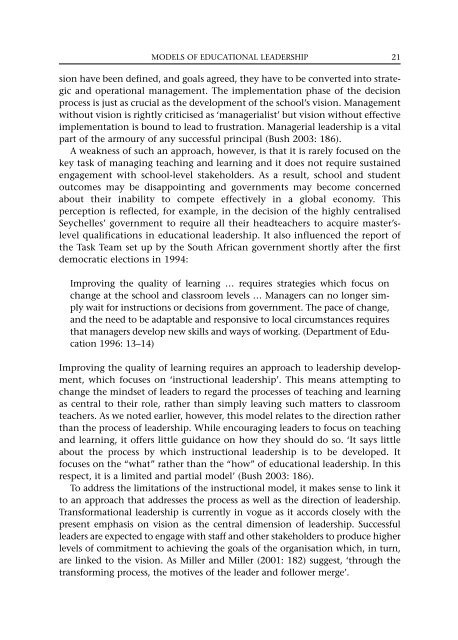Leadership and Management Development in Education (Education ...
Leadership and Management Development in Education (Education ...
Leadership and Management Development in Education (Education ...
Create successful ePaper yourself
Turn your PDF publications into a flip-book with our unique Google optimized e-Paper software.
MODELS OF EDUCATIONAL LEADERSHIP21sion have been def<strong>in</strong>ed, <strong>and</strong> goals agreed, they have to be converted <strong>in</strong>to strategic<strong>and</strong> operational management. The implementation phase of the decisionprocess is just as crucial as the development of the school’s vision. <strong>Management</strong>without vision is rightly criticised as ‘managerialist’ but vision without effectiveimplementation is bound to lead to frustration. Managerial leadership is a vitalpart of the armoury of any successful pr<strong>in</strong>cipal (Bush 2003: 186).A weakness of such an approach, however, is that it is rarely focused on thekey task of manag<strong>in</strong>g teach<strong>in</strong>g <strong>and</strong> learn<strong>in</strong>g <strong>and</strong> it does not require susta<strong>in</strong>edengagement with school-level stakeholders. As a result, school <strong>and</strong> studentoutcomes may be disappo<strong>in</strong>t<strong>in</strong>g <strong>and</strong> governments may become concernedabout their <strong>in</strong>ability to compete effectively <strong>in</strong> a global economy. Thisperception is reflected, for example, <strong>in</strong> the decision of the highly centralisedSeychelles’ government to require all their headteachers to acquire master’slevelqualifications <strong>in</strong> educational leadership. It also <strong>in</strong>fluenced the report ofthe Task Team set up by the South African government shortly after the firstdemocratic elections <strong>in</strong> 1994:Improv<strong>in</strong>g the quality of learn<strong>in</strong>g … requires strategies which focus onchange at the school <strong>and</strong> classroom levels … Managers can no longer simplywait for <strong>in</strong>structions or decisions from government. The pace of change,<strong>and</strong> the need to be adaptable <strong>and</strong> responsive to local circumstances requiresthat managers develop new skills <strong>and</strong> ways of work<strong>in</strong>g. (Department of <strong>Education</strong>1996: 13–14)Improv<strong>in</strong>g the quality of learn<strong>in</strong>g requires an approach to leadership development,which focuses on ‘<strong>in</strong>structional leadership’. This means attempt<strong>in</strong>g tochange the m<strong>in</strong>dset of leaders to regard the processes of teach<strong>in</strong>g <strong>and</strong> learn<strong>in</strong>gas central to their role, rather than simply leav<strong>in</strong>g such matters to classroomteachers. As we noted earlier, however, this model relates to the direction ratherthan the process of leadership. While encourag<strong>in</strong>g leaders to focus on teach<strong>in</strong>g<strong>and</strong> learn<strong>in</strong>g, it offers little guidance on how they should do so. ‘It says littleabout the process by which <strong>in</strong>structional leadership is to be developed. Itfocuses on the “what” rather than the “how” of educational leadership. In thisrespect, it is a limited <strong>and</strong> partial model’ (Bush 2003: 186).To address the limitations of the <strong>in</strong>structional model, it makes sense to l<strong>in</strong>k itto an approach that addresses the process as well as the direction of leadership.Transformational leadership is currently <strong>in</strong> vogue as it accords closely with thepresent emphasis on vision as the central dimension of leadership. Successfulleaders are expected to engage with staff <strong>and</strong> other stakeholders to produce higherlevels of commitment to achiev<strong>in</strong>g the goals of the organisation which, <strong>in</strong> turn,are l<strong>in</strong>ked to the vision. As Miller <strong>and</strong> Miller (2001: 182) suggest, ‘through thetransform<strong>in</strong>g process, the motives of the leader <strong>and</strong> follower merge’.
















